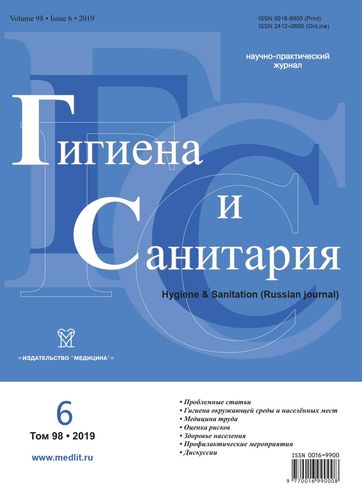On the issue of hygienic requirements for air quality of enclosed spaces at housing construction projects at the stage of commissioning
- Авторлар: Kriyt V.E.1, Sladkova Y.N.1, Badaeva E.A.1, Smirnov V.V.1, Zaritskaya E.V.1
-
Мекемелер:
- North-West Public Health Research Center
- Шығарылым: Том 98, № 6 (2019)
- Беттер: 608-612
- Бөлім: ENVIRONMENTAL HYGIENE
- ##submission.datePublished##: 15.06.2019
- URL: https://vestnik.nvsu.ru/0016-9900/article/view/639581
- DOI: https://doi.org/10.47470/0016-9900-2019-98-6-608-612
- ID: 639581
Дәйексөз келтіру
Толық мәтін
Аннотация
Introduction. In accordance with Presidential Decree No. 204 of May 7, 2018, one of the national development goals of the Russian Federation is to improve the living conditions of citizens. The increase in the volume of standard housing construction and the introduction of advanced technologies in the design and construction will lead to the need to develop clear rules for conducting laboratory and instrumental studies of human-environment parameters when commissioning construction or renovation facilities. The emission of harmful substances in the air of closed premises, which should not have a harmful effect on humans in accordance with art. 20 of the Federal Law of 30.03.1999, No. 52-FZ proved to be one of the most significant environmental factors due to the increase in the number of new buildings and finishing materials used in construction and, as a result.
Material and methods. In this paper, we analyzed the results of laboratory and instrumental studies of indoor air (enclosed) premises, selected at commissioned facilities, performed using both classical methods for the determination of pollutants, and express methods using universal gas analyzers.
Results. The obtained main problems arising during the sanitary-epidemiological examination of the results are considered.
Conclusion. The need to develop regulations for the amount of air research conducted in closed premises to evaluate the object as a whole, taking into account the limiting hazard indicator of the substances must be determined.
Авторлар туралы
Vladimir Kriyt
North-West Public Health Research Center
Хат алмасуға жауапты Автор.
Email: kriyt@s-znc.ru
ORCID iD: 0000-0002-1530-4598
MD, Ph.D., head of the Department of Complex Hygienic Assessment of Physical Factors, North-West Public Health Research Center, 191036, Saint-Petersburg, Russian Federation.
e-mail: kriyt@s-znc.ru
РесейYu. Sladkova
North-West Public Health Research Center
Email: noemail@neicon.ru
ORCID iD: 0000-0003-1745-2663
Ресей
E. Badaeva
North-West Public Health Research Center
Email: noemail@neicon.ru
ORCID iD: 0000-0002-0398-854X
Ресей
V. Smirnov
North-West Public Health Research Center
Email: noemail@neicon.ru
ORCID iD: 0000-0002-6627-494X
Ресей
E. Zaritskaya
North-West Public Health Research Center
Email: noemail@neicon.ru
Ресей
Әдебиет тізімі
- Kostenko V.A. European, American and Russian regulatory requirements for ventilation and air conditioning. Tekhnika. Tekhnologii. Inzheneriya. 2017; 2: 6-10. (in Russian)
- Dudarev A.A., Sorokin G.A. Actual problems of occupational health and occupational pathology of office workers. Medicina truda i promyshlennaya ehkologiya. 2012; 4: 1-8. (in Russian)
- Zaripova L.R., Ivanov A.V., Tafeeva E.A. Housing environment and public health. Sovremennye problemy nauki i obrazovaniya. 2015; 5: 161. (in Russian)
- Dedkova L.A., Liseckaya L.G. Formaldehyde emission into indoor air. Byulleten’ VSNC SO RAMN. 2011; 3 (79), ch. 2: 76-9. (in Russian)
- Dudarev A.A., Turubarov V.I. Artificial air ionization as an indicator of air quality (hygienic, medical and technical aspects). In.: Sotnikov A.G., ed. Processes, apparatus and systems of air conditioning and ventilation. Theory, technology and design at the turn of the century. SPb.: AT-Publishing; 2005; t. 2, chast’ 1, razdel 9.3: 298-317. (in Russian)
- Kir’yanova M.N., Markova O.L., Ivanova E.V. Topical issues of air quality office space. In.: Materials of the All-Russian scientific-practical conference with international participation «Preventive medicine – 2017». SPb.; 2018; ch. II: 9-14. (in Russian)
- Novackij V.E., Sladkova YU.N., Zarickaya E.V. Sampling to assess the air quality of enclosed public buildings. In.: Materials of the XII All-Russian Congress of Hygienists and Sanitary Physicians «Russian hygiene - by developing traditions, we aspire to the future». SPb.; 2018; t. 2: 728-30. (in Russian)
- Sladkova YU.N., Smirnov V.V., Zarickaya E.V. On the issue of hygienic regulation of microclimate and air quality in office premises. Medicina truda i promyshlennaya ehkologiya. 2018; 5: 35-9. (in Russian)
- Dorogova V.B. Features of sampling of atmospheric air and indoor air for the determination of pollutants. Gigiena i sanitariya [Hygiene and Sanitation, Russian journal]. 2010; 6: 85-6. (in Russian)
- Yаkubova I.SH., Dadali YU.V., Mel’cer A.V., Alikbaeva L.A., ZHirnov A.YU., Andreeva M.A. et al. Methodical issues of monitoring ammonia in the air of enclosed spaces. Gigiena i sanitariya [Hygiene and Sanitation, Russian journal]. 2016; 95 (10): 917-22. (in Russian)
- Sladkova Yu.N., Zarickaya E.V., Smirnov V.V. Topical issues of air quality assessment of indoor premises of residential and public buildings. In.: Materials of the All-Russian scientific-practical conference with international participation «Preventive medicine – 2017» SPb.; 2018; ch. III: 73-7. (in Russian)
- Zarickaya E.V., Sladkova YU.N., Smirnov V.V. Indoor air: current problems, health effects, preventive measures. Sanitarnyj vrach. 2018; 4(171): 49-55. (in Russian)
- Neplohov A.A., Salihova L.R., Neplohov A.I., Dunaev V.N. The risk to public health when exposed to chemicals in the air of enclosed spaces and residential areas of an industrial city. Gigiena i sanitariya [Hygiene and Sanitation, Russian journal]. 2009; 4: 89-90. (in Russian)
- Krijt V.E., Sladkova YU.N. The main problems of hygienic regulation of the microclimate of residential and public buildings. In.: Materials of the XIII Annual All-Russian Scientific and Practical Conference with International Participation «Health is the Basis of Human Potential: Problems and Solutions». SPb.; 2018; t. 13; ch. II: 843-53. (in Russian)
Қосымша файлдар







